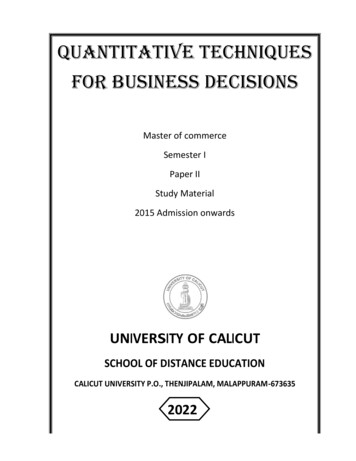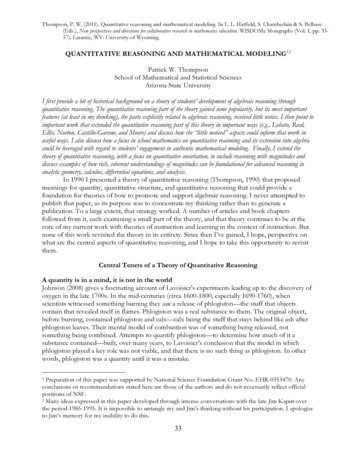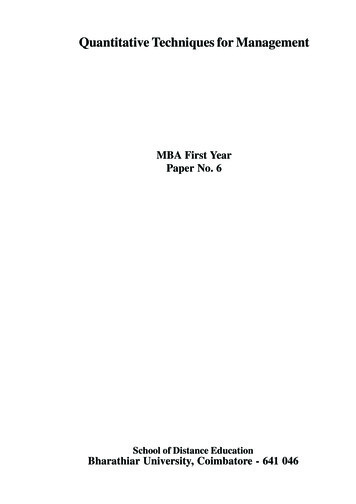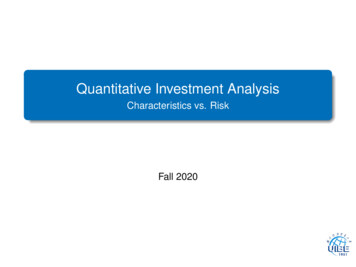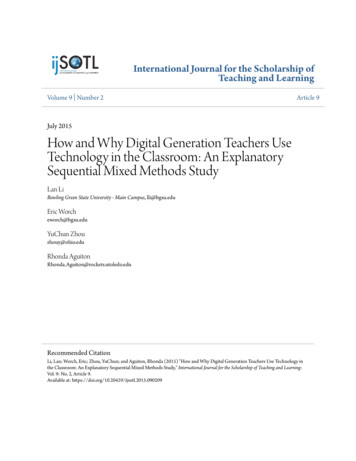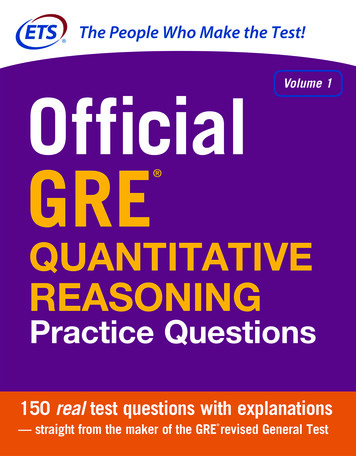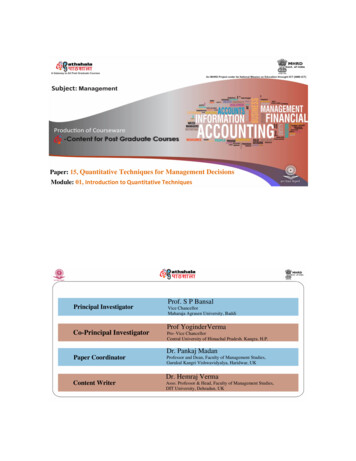
Transcription
Paper: 15, Quantitative Techniques for Management DecisionsMANAGEMENTDECISIONSModule: 01, Introductionto Quantitative TechniquesPrincipal InvestigatorCo-Principal InvestigatorProf. S P BansalVice ChancellorMaharaja Agrasen University, BaddiProf YoginderVermaPro–Vice ChancellorCentral University of Himachal Pradesh. Kangra. H.P.Dr. Pankaj MadanPaper CoordinatorProfessor and Dean, Faculty of Management Studies,Gurukul Kangri Vishwavidyalya, Haridwar, UKDr. Hemraj VermaContent WriterAsso. Professor & Head, Faculty of Management Studies,DIT University, Dehradun, UK
ItemsSubject NamePaper NameModule TitleModule IdPre- RequisitesObjectivesKeywordsDescription of ModuleManagementQuantitative Techniques for Management DecisionsIntroduction to Quantitative TechniquesModule No.-01Basic understanding of Business DecisionsTo apprise students about relevance of quantitative techniques inbusiness decision making in today’s competitive worldQuantitative techniques, Business decision making, statisticsQUADRANT-IModule-15 Introduction to Quantitative Techniques1. Learning Outcome2. Introduction3. Decision Making basics4. Role of quantitative techniques in business decision making5. Classification of quantitative techniques6. Scope of quantitative techniques7. Summary1.Learning Outcome:After completing this module the students will be able to understand: the meaning of quantitative techniques basics of decision making the relevance of quantitative techniques in business decision making the classification of quantitative techniques the various quantitative tools available for business decision making2. IntroductionQuantitative techniques can be understood as a collection of mathematical and statistical toolsthat are used to provide powerful means of analysis using quantitative data for effective decisionmaking in business. These techniques involve systematics and scientific methods for solvingcomplex problems for taking effective business decisions.Quantitative techniques involve the use of numbers symbols, mathematical expressions, andother elements of quantities, and serve as supplements to the judgment and intuitions of thedecision makers. These tools help businesses in optimum utilization of limited resources.Traditionally, quantitative techniques are understood by different names such operation research,or management science. More recently, statistical techniques are also understood to have beenpart of quantitative techniques.
3. Decision makingDecision making pervade all aspects of the business. The verb decide has been derived fromLatin prefix ‘de’ and the word ‘caedo’ meaning “off” and “to cut” respectively. This led to originof the word “Decido ” or deciduous, referring to those plants the leaves of which fall in theautumn. But that is only one meaning of it. Other word derived from it is “decide” that means“take the plunge” suggesting the meaning of in which making a wrong decision provokes thefear of falling.As per Drucker long range planning deals with the futurity of present decisions rather than futuredecisions. Thus it relates present planning and future events. Current decisions should be madekeeping in mind the anticipated effect and the outcome of events that influences future valuesand decisions. Decisions should balance efficiency with flexibility, and existing opportunities toreact to future circumstances and needs.Decision making processDecision making is systematic process involving several steps such as identifying the problem orissue, identifying decision criteria, allocating weights to decision criteria, generating alternatives,evaluating and choosing an alternative, implementing the decision alternative and finallyevaluating if the decision alternative was effective or not. For example, If an organization isdeciding to buy laptops for its 500 employees, then it needs to first find out why these laptops areneeded, the kind of configuration needed in those laptops, the price, quality, service warrantiesthat different vendors will be charging, evaluating a set of vendors and then take a decision toorder from a vendor.Decision making, Rationality and Bounded RationalityIt is assume that managers make rational decision making by making logical and consistentchoices to so as to maximize value. But it may not be possible as right and timely information tomake fully rational decisions is not available in most of the situations. The decision of HewlettPackard (HP) acquiring Compaq is an example of poor decision making on the part of then CEO,Carly Fiorina who even lost her job as company did no research to discover that customersperceived Compaq products as inferior—just the opposite of what customers felt about HPproducts—it was too late.Therefore, making a rational decision may be ideal expectation but not realistic one. A morerealistic approach to make decisions is the concept of bounded rationality. As per this conceptmanagers make decisions rationally, but are limited (bounded) by their ability to processinformation. It is not possible for managers to evaluate all information on all alternatives andtherefore most managers take satisficing decision rather than a decision that will maximizehis/her gain. That is, they accept solutions that are “good enough.”Role of Intution in decision makingWhen a manager makes a decision based on his experience, feelings, and accumulated judgment,we may say that he or she is taking decision based on his intuition. Researchers have identifiedfive different aspects of intuition as Experience based decisions, affect-initiated (feeling or
emotion based), Cognitive based decisions, Subconscious mental processing and value or ethicsbased decisions.Types of decsisionsDecsision can be structured and programmed or unstructured and non-programmed. When theproblems are routine or straitforward we solve them by creatiung rules, procedures or policiesetc. But if the problem is unique and complex then we need a detailed analysis to reach to asolution.Decision Making under Certainty, Risk and UncertaintyThe decision are made under any one of the condition i.e. under Certainiity or Risk orUncertainity. Under conditions of cenrtainty, a manager makes most accurate decsions as he isaware of outcome of every action beforehand. This is one of the most desirable situation but ismostly unrealistic.Exactly opposite to it would be decsion making under condtiiion of uncertainty where a manageris not at all aware of possible outcomes of his choice of alternatives. He is not even in a positionto make some probable geuss. Here alternatives are chosen by a manager’s intution, judgement,hunch and his psychological orientation.The most common situation faced by managers is one of risk in which the decision maker is ableto estimate the likelihood of certain outcomes. Under risk, managers utilizes historical data fromsecondary sources or from personal experiences and assign probabilities to different alternatives.4. Role of Quantitative Techniques in Business decision makingDecision making is one of the most fundamental activity in any business and is very crucial forits survival, growth and success. Be it a decision to enter a new market, design a product, hirepeople, raise funds or decide something similar, all these situations would require a manager toevaluate various available options to choose the best for being effective. Most of the times, thesedecisions are taken in an environment where there is lack of requisite information and otherimportant resources such as men, money and machine apart from constraints of time, cost andspace. This makes decision making very difficult and therefore demands a logical approach tofinalize a course of action.Traditionally, most of the decision were based on intuition, experience and judgment of thedecision maker. Using data for taking decision was almost unheard of and therefore, decisiontaken in that manner were certainly not the most beneficial to an organization. In fact, it wasuntil 19th century when Frederick W. Taylor experimented in factory set up to solve problem ofproductivity using scientific method. The evolution of industrial engineering, scientificmethodologies that were prominent earlier in the natural sciences, were found applicable tomanagement functions-planning, organizing and controlling of operations. Today most of thebusiness decisions are taken with the help of one or many of quantitative techniques available toa manager. Not that quantitative techniques have replaced institution and judgment, rather thesetechniques have supplemented these to make decisions more effective.
Specifically, these techniques are helpful in managing production by identifying the right site forsetting up factory, scheduling the production process correctly, controlling wastage, producingoptimum lot sizes & product mix etc. Further, Human resource management decisions such asmanpower planning, methods of recruitment, selection, training, compensation, can also beoptimized using these techniques. In marketing too, these techniques can be quite useful indetermining right distribution & warehousing points and levels of customer satisfaction. In fact,all 4 P’s related decisions in marketing can be taken more effectively using these techniques.Even for finance related decision such as raising funds from appropriate sources, determiningpolicies related to replacement, managing a profit plan, estimating credit and investment risk,quantitative tools are very useful.5. Classification of Quantitative TechniquesBroadly, there are two types of quantitative techniques- Mathematical and statistical quantitativetechniques.Mathematical quantitative techniques process quantitative data using principles of mathematics.These include wide range of tools such as Algebra, Set theory, Permutations and combinations,Matrix Algebra, Determinants, Differentiations, Integration, Differential equations etc. Inaddition to this, there are several mathematical programming techniques that includes linearprogramming, Assignment and Transportation models, dynamic programming, Inventorycontrol, game theory, queuing theory, replacement models, simulations, decision theory, networkprogramming, Sequencing, Quadratic programming, Branch & bound techniques etc. which arevery useful and are widely used to reach at effective business decisions. Most of thesemathematical techniques result in decision models that are deterministic in nature.The second type of quantitative techniques involve statistical enquiry to solve business problemsand include variety of statistical tools used for analyzing data for better decision making. Thispart of quantitative techniques deal with understanding the use of statistics in business decisionmaking. Since decision making is based on information availability, therefore it becomesimportant that correct and timely information is obtained in the form of well documented data.Many a times, the data may be readily available from secondary data sources but there may besituations where a manager need to generate fresh data from primary sources by carrying outsurveys. The decision in this case will include activities ranging from methods of data collectionto data analysis. Most of models developed using statistical techniques include probabilisticmodels of decision making with the presence of random error. These techniques consists of toolssuch asa) Data classification, tabulation and presentation
b)c)d)e)f)g)h)i)j)k)Measures of Central tendencyMeasures of dispersionProbability & probability distributionsSampling and Sampling DistributionsEstimation theoryHypothesis Testing and decision makingAnalysis of Variance (ANOVA)Correlation and Regression AnalysisForecasting using Time-Series analysisFundamentals of Decision theoryThough statistical techniques also include several multivariate analysis tools but that is beyondthe scope of this course.6. Scope of the courseAs discussed in the previous section, there are a large number of quantitative techniquesavailable of business decision making. However, it will beyond the scope of this course todiscuss all of them here. For simplicity and practicality, the current course will only coverfollowing topics related to statistical quantitative techniques–a) Basic of Business StatisticsStatistics has been defined as a science dealing with the collection, analysis,interpretation, and presentation of numerical data. (Webster’s Third New InternationalDictionary). Statistics can be classified in two ways – descriptive and inferentialstatistics. When we use data gathered of a group to describe or reach conclusions aboutthat same group, the statistics are called descriptive statistics. For example, if aninstructor gathers information about marks scored by students in his class andsummarizes the information that most of students have scored above average andtherefore reach to conclusions that class has learnt lesson well, then it will be an exampleof descriptive statistics. Second type of statistics is called inferential statistics. When amanager or researcher collects data from a sample and uses this sample statistic to reachconclusions about the population characteristic we call it inferential statistics. The datagathered from the sample are used to infer something about a larger group.b) Data classification, tabulation and presentationRaw data or ungrouped data is generally cumbersome to handle and interpret. Therefore,it is slightly difficult to come out with meaningful information for decision making basedon it. In statistics, there are several tools available for summarizing and presenting thedata such as frequency distributions, stem-and-leaf plots, histogram, frequency polygons,Ogive curves, box plots, bar chats, pie charts, pareto charts (for single variable) andscatter plots (for two variables)c) Measures of Central tendency
At times we feel the need to describe a given dataset with one single representative value,usually a middle value .For example, a professor of statistics would like to know how hisstudents have fared in Business statistics course. Similarly, a shoe manufacturingcompany may be interested in knowing which number shoes shall be manufactured infactory to earn maximum profit. In such situations, we need a value that represents agiven dataset well enough to enable a manager to make good decision.This representative central value of a dataset is called as measures of central tendencyand can be in the form of Mean, median, mode. Here mode is most frequently occurringvalue in a dataset, median is middle value in an ordered dataset, and mean is the sum ofnumbers divided by number of values in a dataset. One simple way to find this out couldbe finding out the mean marks of the class in the course.d) Measures of dispersionThese are also known as measures of variability in the dataset. Two most commonly usedmeasures of dispersion are variance and standard deviation. Variance represents averagesquared deviation of given values from actual mean in the dataset. Standard deviation iscalculated as under root of variance. Both of these measures of variability give an idea ofshape of frequency distribution. If the values in a dataset are closer to each other i.e.mean, then its variance is likely to be very less. These two measures help in decisionmaking in most of business situations. For example, if there is high variance in the life ofa led bulb, then customers are less likely to buy it. Similarly, an IPL team owner is lesslikely to buy a player if there is a high standard deviation or variance in his battingaverage.Skewness and Kurtosis are two other important indicators of dispersion that help usanalyze the shape of a frequency distribution curve. A distribution of data in where bothhalves i.e. right half and left half are mirror images of each other, then it is called assymmetrical. Normal distribution, or bell shape curve is an one example of a symmetricaldistribution. But when the distribution of a data is not symmetric or is asymmetric, it iscalled as skewed distribution. If the long and thin part of the curve is on the left side, it iscalled as left or negatively skewed and if it is on right side then it is called as right orpositively skewed (fig. below). An Instructors may sometimes refer to a gradedistribution as skewed, if few students scored at one end of the grading scale, and manystudents scored at the other end.
Kurtosis describes the peakedness of the data distribution. Distributions that are high andthin are referred to as leptokurtic distributions. Distributions that are flat and spread outare referred to as platykurtic distributions. Between these two types are distributions thatare more “normal” in shape, referred to as mesokurtic distributions.e) Probability & probability distributionsIf it is said that there are 90% chances of rain tomorrow, then how is it going to affectplanning for tomorrow? May be some of you will carry an umbrella with him/her tooffice. A cricket match may be rescheduled for future date, an open theatre commercialevent may be relocated to new venue, and the route of trucks in a fleet company may bererouted if the prediction is for very heavy rain. In short, probability affects all of us,almost, in every aspect of our lives. Especially in managerial decision making, it hasgreat utility as most of the business decisions involve a chance factor in their success orfailure. Probability can be understood as a chance of happening or not happeningsomething. Its value always lies between 0 to1 and always expressed in decimals orfractions.Probability distributions are theoretical frequency distributions that explain how theoutcomes of an event are expected to vary. These distribution are very useful in drawinginferences and making decisions under conditions of uncertainly. Take a case of aninvestor who would like to invest in a company’s stock if it gives him or her a return of10%. The current cost of each share of this company is 150 Rs. Also assume that throughsome past analysis he has been able to find the possible return as Rs. 0, 10, 15, 25, 50with their respective probabilities as 0.20, 0.25, 0.30, 0.15 and 0.10 for the mentionedstock. With the given probability distribution the investor will be able to take a decisionto invest or not invest in the company’s stock. All he needs to do is compare the requiredreturn of Rs. 15 (10% of 150 Rs) with expected return Rs. 15.75 (0 x 0.20 10 x 0.25 15 x 0.30 25 x 0.15 50 x 0.10) to go in the favor of investing in the stock.Broadly, probability distributions can be classified as discrete or random. In discreteprobability distributions, a random variable can only take discrete probability values. Forexample, the probability that an individual is born can only take one of the 12 values asthere are only 12 months. Though there are many discrete probability distributions butthis course will be limited to the discussion of only two widely used discrete probabilitydistributions viz. Binomial distribution and Poisson distribution.In continuous probability distributions, a random variable can take any value within agiven range. Take for example, a business school claims that the average packagereceived by their MBA students is 10 lac per annum with a standard deviation of 1.5 lacp.a. So what is the probability that a student selected at random would be getting a
package of less than 8 lac p.a. In such a scenario, the continuous distribution will help usfind this probability.Again, there are number of continuous probability distributions but discussion in thiscourse will be limited to normal, z, t and F distributions.f) Sampling and Sampling DistributionsIn several situations, it may not be practically possible to study the entire populationbecause of resource constraints. Yet we may be need some information about thepopulation characteristics to take important business decisions. For instance, a big carmanufacturing company such as Maruti Suzuki in India may wish to know thesatisfaction level of its customers so that it can continue producing cars or bring changesin the existing products. To find this, one of the option available to company is contact allcustomers, which may be in crores by now, and ask about their satisfaction. It is verymuch possible but would require lots of money, men and time. Practically, it would bevery difficult to hold such kind of study that will include every member of population i.e.customers in the study. In such a scenario, the company always has an option of choosinga small sample of customers and then draw inferences about population satisfaction.There will always be some random error in estimation but with the help of samplingdistributions, we can always calculate such probabilities and take faster and efficientdecisions. So in nutshell, sampling is a way of choosing a part of population with apurpose of drawing some inferences about population characteristics.A sampling distributions may be understood as a probability distribution of all possiblemeans of various samples drawn from a population. For example, if we wish to know theaverage mileage of cars of a company and we have only four cars A, B, C, D, aspopulation. To choose a sample of any two cars, we will have six sample combination ofcars (AB, AC, AD, BC, BD, CD). Now if we take mean of mileage of every samplecombination and draw their frequency distribution, it will be called a samplingdistribution of means.g) Estimation theoryEstimation theory has a lot of relevance in business decision making. A manager workingin different capacities would like to estimate one thing or other while taking businessdecisions –A marketing manager would estimate the demand for its products inforthcoming year, a production manager may estimate the raw material requirements, anHR manager would like to estimate manpower requirements and a finance manager,similarly, would like to estimate fund requirement for next financial year.Traditionally these decisions were largely based on hunch but now, with the help ofquantitative techniques i.e. statistics, we may use estimation theory to reachapproximately to a rational decision. Probability theory forms the bases of statistical
inference and this further is based on estimation and hypothesis testing. In other words,we try to estimate the characteristics of a population from a sample in a way that theestimate reflects the true population characteristics to the closest.Estimates can be made in ways – point estimate and interval estimate. While pointestimate is a single number through which we estimate a population parameter, aninternval estimate will give a range of values within which a population parameter willfall with some prior calculated probability. For example, if a manager is making a pointestimate about demand she or he may come out with a single number such as Rs.100crore. Whereas, an interval estimate of demand forecast will be a range such as Rs.75- 125 crores. In former kind of estimation, there is an inherent limitation, as manager’sestimate would either be right or it would be wrong with more chance of him beingwrong. However, in interval estimates the chance that the manager is right will be quitehigh.h) Hypothesis Testing and decision makingTesting of hypothesis is an important statistical tool to judge the reliability of inferencesdrawn on the basis of sample studiesIn business, we always make one or other claim about possible situations or outcome of adecision. For example, internal recruitment is more effective source of recruitment, olderemployees are less efficient, females get lessor salary than males etc.A hypothesis is an assumption or claim that we make about a population parameter(population mean, standard deviation, and variance). Since most of the times, it is notpossible to study whole of population due to time and resource constraints, we make anattempt to estimate a population parameter using a sample statistic (sample mean,standard deviation, and variance). To test the validity of the claim made about apopulation, a sample data is collected and then find out the difference betweenhypothesized value and actual value of the sample mean. Then using probabilitydistributions (in this case sampling distribution), we find out if the difference issignificant or not. This significant of difference not determined merely by intuition butrather is concluded using statistics.Imagine a business school claiming that an MBA graduate in their campus gets anaverage salary of Rs.10 lakhs with a standard deviation of Rs. 10000. To test this claim,you picked up a sample of 49 passed out students and calculated their average salary asRs.9.95 lakh p.a. By intuition you may always conclude that the difference between apopulation claim i.e. 10 lakh and sample value i.e. 9.95 lakh is very small i.e. Rs. 5000 soas to treat it as insignificant. However, the result will be otherwise if we use statisticshere to accept or reject our hypothesis.Hypothesis are, conventionally, formulated as Null and Alternate hypothesis. Nullhypothesis represents a situation of no change, status quo, no impact or no relationship
between variables of interest. Whereas an alternate hypothesis is exactly opposite of whatis there in null hypothesis i.e. a significant change, significant impact or relationshipbetween variables.Hypothesis testing may be done using several tests such as Z test, T-Test, Paired t test,Independent sample t-test, Chi square test, F-tests etc.i) Analysis of Variance (ANOVA)Analysis of Variance (ANOVA) is a technique through which we can test thesignificance of differences among more two sample means simultaneously. In this, thetotal variation is decomposed into various components corresponding to the sources ofvariation. Using this technique, we can draw inferences about whether our samples aredrawn from the same population or populations having same means.For instance, an HR manager may like to find out if satisfaction level across threedepartments (Marketing, Finance and HR) are same or different. The manager may get anaverage satisfaction score of 7, 6, 8 for Marketing, Finance & HR departmentsrespectively. Now to compare these there mean satisfaction scores, we can use ANOVAtechnique to test following hypothesis –H0: All three means are equalHa: At least one of the means is different from the others.Depending upon how many dependent variables, independent variables and extraneousvariables we have in our research design we may choose between variety of ANOVAtechniques such as One way Anova, Two Way Anova, Factorial Anova, Manova,Anacova etc.j)Correlation and Regression AnalysisIn business, there are several situations, when one may find that two variables appear tobe related. For example, Motivation at workplace may be related to performance basedincentives, Performance may be related to age, gender, educational qualification, worklife balance etc. In such cases, a manager always feels a need to know more accuratelyabout these relationships through some tangible quantitative measures. One suchquantitative measure in statistics is Correlation.Correlation describes the degree and direction of relationship among two or morevariables. Its value lies between -1 to 1 with values near to 0 indicating a weakcorrelation and values closer to 1 indicating strong correlation. Though value ofcorrelation coefficient can also take a negative value such as - 0.8 but one should becareful to interpret the negative sign as an indicator of direction of relationship only(Positive or negative relationship) and take absolute value ignoring sign for interpretingstrength of relationship between variables of interest.r One the limitation of correlation is that we can always tell that two or more variables arehighly or weakly and positively or negatively correlated but we can never say that
variable X is influencing variable Y. For this purpose we have a concept called regressionin which we can find out the impact that one variable X may have on other variable Y.Regression, though, can be used for number of purposes in business situations. First, itcan check if any relationship exists between a dependent variable and a set ofindependent variables. Second, it can be also be used to find out the relative importanceof various independent variables in impacting dependent variable. Still further, regressioncan also be used for predicting values of dependent variable Y for a given value ofindependent variable X.A simple regression model may be expressed as below Y a bX uHere Y Dependent VariableX Independent Variablea Intercept i.e. value of Y when X is zerob Regression coefficient or parameter to be estimatedk) Forecasting using Time-Series analysisForecasting is all about predicting future. Be it predicting manpower requirements, rawmaterial requirements, demand for products, fund requirements or predicting some otherrequirement, forecasting is needed for all kinds of business decision making inorganizations. Virtually all functional areas of business, including production, sales,employment, transportation, distribution, and inventory, produce and maintain time-seriesdata.For prediction, time series forecasting is one of popular technique that makes predictionusing data gathered on a given characteristics over a period of time. For instance, salesdata of past ten or more years can be used to predict the sales for forthcoming year. Timeseries forecasting techniques takes into account the changes happening in acharacteristics such as sales by examining patterns, trends, cycles etc. over the period of atime. There are various methods available for time series forecasting such as naïvemethods, moving average, exponential smoothing, regression trend analysis, and thedecomposition of the possible time-series factors,l)Fundamentals of Decision theoryThe decision theory deals with those mathematical and statistical appr
These techniques involve systematics and scientific methods for solving complex problems for taking effective business decisions. Quantitative techniques involve the use of numbers symbols, mathematical expressions, and other elements of quantities, and serve



